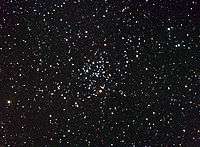Messier 50
Messier 50 or M 50, also known as NGC 2323, is an open cluster of stars in the constellation Monoceros. It was recorded by G. D. Cassini before 1711 and independently discovered by Charles Messier on April 5, 1772 while observing Biela's Comet. It is sometimes described as a 'heart-shaped' figure or a blunt arrowhead.[3]
| Messier 50 | |
|---|---|
 Messier 50 can be located 8° north and 3° east of Sirius | |
| Observation data (J2000 epoch) | |
| Constellation | Monoceros |
| Right ascension | 07h 02m 47.5s[1] |
| Declination | −08° 20′ 16″[1] |
| Distance | 2,870 ly (881 pc)[2] |
| Apparent magnitude (V) | 5.9[3] |
| Apparent dimensions (V) | 16.0′[3] |
| Physical characteristics | |
| Mass | > 285 M☉[4] M☉ |
| Radius | 8.9 ly (2.73 pc)[4] |
| Estimated age | 140[1] Myr |
| Other designations | M50, NGC 2323, Cr 124, C 0700-082, OCl 559[5] |
M50 is at a distance of about 3,000 light-years away from Earth[2] and is located near the edge of the CMa OB1 association.[4] It has a core radius of 5.9 ly (1.8 pc)[6] and spans 17.8 ly (5.46 pc).[4] The cluster has a 508 confirmed members with a combined mass of more than 285 M☉, for a stellar density of 1.3 stars per cubic parsec.[4] It is around 140 million years old,[1] with two high-mass white dwarfs[7] and two chemically peculiar stars.[8]
Gallery
References
- Frolov, V. N.; et al. (February 2012), "Investigation of the open star cluster NGC 2323 (M50) based on the proper motions and photometry of its constituent stars", Astronomy Letters, 38 (2): 74–86, Bibcode:2012AstL...38...74F, doi:10.1134/S106377371202003X.
- Kharchenko, N. V.; et al. (2005), "Astrophysical parameters of Galactic open clusters", Astronomy and Astrophysics, 438 (3): 1163–1173, arXiv:astro-ph/0501674, Bibcode:2005A&A...438.1163K, doi:10.1051/0004-6361:20042523.
- Thompson, Robert; Thompson, Barbara (2007), Illustrated Guide to Astronomical Wonders: From Novice to Master Observer, DIY science, O'Reilly Media, Inc., p. 321, ISBN 978-0596526856
- Claria, J. J.; et al. (February 1998), "Photometric study of the open cluster NGC 2323", Astronomy and Astrophysics Supplement, 128: 131–138, Bibcode:1998A&AS..128..131C, doi:10.1051/aas:1998130
- "M 50". SIMBAD. Centre de données astronomiques de Strasbourg. Retrieved 27 November 2018.
- Sharma, Saurabh; et al. (May 2008), "Mass Functions and Photometric Binaries in Nine Open Clusters", The Astronomical Journal, 135 (5): 1934–1945, arXiv:0803.0122, Bibcode:2008AJ....135.1934S, doi:10.1088/0004-6256/135/5/1934.
- Cummings, Jeffrey D.; et al. (February 2016), "Two Massive White Dwarfs from NGC 2323 and the Initial-Final Mass Relation for Progenitors of 4 to 6.5 M", The Astrophysical Journal, 818 (1): 13, arXiv:1601.03053, Bibcode:2016ApJ...818...84C, doi:10.3847/0004-637X/818/1/84, 84.
- Paunzen, E.; et al. (April 2014), "Photoelectric search for peculiar stars in open clusters. XV. Feinstein 1, NGC 2168, NGC 2323, NGC 2437, NGC 2547, NGC 4103, NGC 6025, NGC 6633, Stock 2, and Trumpler 2", Astronomy & Astrophysics, 564: 8, arXiv:1403.3538, Bibcode:2014A&A...564A..42P, doi:10.1051/0004-6361/201423521, A42.
External links
| Wikimedia Commons has media related to Messier 50. |


